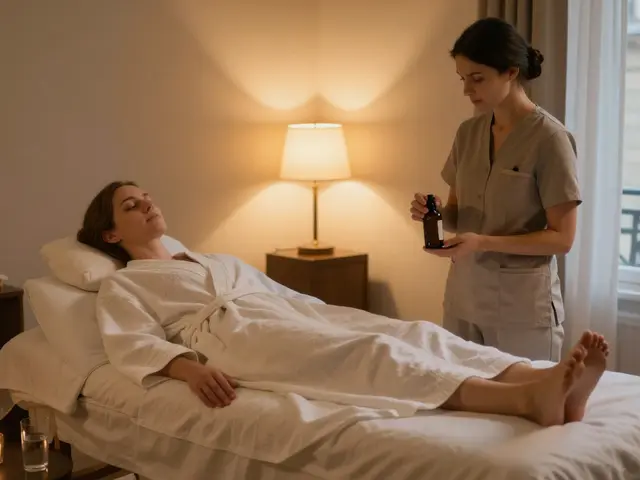Ever stretched out on a massage table and felt your stress dissolve like sugar in hot coffee? For most of us, body massage is pure magic. Even a short session can leave you lighter, looser, and ready to take on just about anything. But here’s the kicker: massages aren’t just a luxury—they’re a science-backed way to reboot your mind and body. Dive into the world of massage, and you’ll find so much more than scented candles and background music. There’s a whole toolkit of techniques, unexpected perks, and insider tips that can change how you think about recovery, stress, and daily living.
What Happens to Your Body During a Massage?
Let’s talk science for a second. When you’re lying face-down with someone kneading your muscles, your body’s not just relaxing—it’s shifting gears on a deep, biological level. For starters, massage increases blood flow. Think of it as your muscles getting a tailor-made delivery of oxygen and nutrients, helping them heal and perform better. Your nervous system also gets the memo: as gentle pressure hits your skin, your brain releases ‘feel-good’ chemicals like serotonin and dopamine. These are the same neurotransmitters that fire off when you fall in love or eat the world’s best chocolate.
Here’s something most people don’t realize: regular massage turns down your stress response. You know that tight feeling in your shoulders after a long day? Massage physically tells your body to let go—and the effect is measurable. In a 2023 study published by the European Journal of Integrative Medicine, participants who had weekly massages showed a 35% drop in cortisol (that’s the stress hormone) compared to those who didn’t. Literally, your body reacts to skilled touch by entering a state scientists call the ‘rest and digest’ mode. Your heart rate drops, your breathing slows, and even your digestion improves.
Massage also does a little magic for your immune system. Swedish-style massage, the most popular form worldwide, has been shown to boost white blood cell count. This means you’re more ready to fight off colds and infections. Just one 45-minute session can kick your immune system into higher gear, according to research from Cedars-Sinai Medical Center. But the benefits don’t stop there. Massage also helps flush out metabolic waste, reduces pain signals, and can even improve your sleep cycles.
Here’s a quick look at some of these effects:
| Physiological Effect | What Massage Does | Result |
|---|---|---|
| Circulation | Increases blood flow | Better muscle recovery |
| Hormones | Lowers cortisol | Less stress |
| Immunity | Stimulates white blood cells | Improved defense against illness |
| Sleep | Triggers relaxation response | Deeper, more restful sleep |
When you finish a session and everything feels softer and quieter, it’s not just in your head. Your body is working behind the scenes to heal faster, recover from stress, and find a little bit more peace.
The Many Faces of Massage: Techniques that Change Everything
Stroll through Paris and you’ll spot dozens of spas, each promising relaxation, but the world of massage has a whole lot more flavor than most people realize. Swedish massage tops the charts—it’s all about gliding strokes, kneading, and gentle tapping, and is perfect if you want to ease tension and boost circulation. It’s the safe bet for first-timers. But maybe you’re craving something deeper? Then there’s deep tissue massage. Here, therapists use slower, firmer pressure to reach the thick knots buried in your muscles—the spots that flare up after working at your desk for hours or from pushing too hard at the gym.
If you want a massage that’s almost dance-like, try Thai massage. It’s performed on a mat, and you stay fully clothed. The therapist uses their hands, knees, legs, and feet to guide you through stretches and pressure points. It’s like yoga—but you don’t actually have to do anything. Then there’s hot stone massage, a real crowd-pleaser in the colder months. Smooth, heated stones are placed strategically on your body and used as extensions of the therapist’s hands. The warmth melts away tension and helps your mind drift off.
Some folks are all about aromatherapy massage. Here, scented oils—like lavender for calm or eucalyptus for energy—get massaged into the skin. The smells work directly on your brain’s limbic system (where feelings live), enhancing the chill-out factor or giving you an unexpected mood boost. Into something more targeted? Reflexology focuses on specific points on your feet, said to correspond to organs and systems in your body. It’s a surprising way to alleviate headaches, back pain, or even digestive issues.
Let’s not forget about sports massage for anyone clocking in serious mileage in their sneakers. It combines deep tissue moves with stretching and is designed to help athletes bounce back. And for those looking for a softer touch, lymphatic drainage uses very light, rhythmic strokes to boost the body’s natural detox process—great for reducing swelling after travel or surgery.
- Pro tip: Not sure what style suits you? Tell your therapist about your goals and any pains or preferences. A good therapist will tweak the massage to fit you, blending techniques for the best results.
Mash together all these techniques, and you get a toolkit ready to tackle anything—tight muscles, mind fog, or burnout. No matter your need, there’s a massage method that fits.

Why a Paris Massage Hits Different: The Local Experience
You might wonder—what makes getting a body massage in Paris so special? Once you’ve arrived in the city, you realize that relaxation is practically embedded into the culture. Parisians know how to savor life, and their approach to wellness is no different. Walk into any Parisian spa and you’ll notice the difference: attention to ambiance, softness in lighting, and therapists who act like relaxation artists. Some of the best massages in town are hidden in tiny, fragrant boutiques tucked behind flower shops or up spiral staircases in historic buildings.
French massage therapists are often trained in several techniques and tend to take a holistic view—they’ll ask about how you sleep, how you move, and what’s causing you stress. They’ll even ask about your upcoming plans in the city, suggesting massages before or after flights, shopping sprees, or long museum days. And don’t be surprised if there’s a bit of French flair—think herbal compresses, hydrating facials blended with your massage, or hot-oil scalp work that leaves you feeling extra polished.
Some of the city’s oldest spas, like the storied Les Bains du Marais, have been serving up steams, scrubs, and massages since the 1900s. But cool new spots are always popping up, with fresh ideas like digital detox massage, where smartphones are confiscated and your tension is kneaded away with a side of mindfulness. If you want to splurge, there’s even the option of chocolate oil massage—wild, right?—where Paris’s sweet tooth meets your skin.
The point is, Paris treats massage like an experience, not a transaction. There’s more ceremony, more thought put into making you feel truly welcome and at ease. That might mean champagne after your massage, access to thermal pools, or little tastes of local delicacies in the relaxation lounge. When you leave, you carry a piece of that Parisian calm with you, a sense that life’s tempo just got a little slower and sweeter.
Tips to Make the Most Out of Every Massage
You can absolutely get more out of your massage if you play it smart. Here’s some advice straight from seasoned therapists and regulars who’ve mastered the art of the unwind:
- Communicate: Don’t be shy—tell your therapist about injuries, soreness, and even what mood you’re in. They’ll tailor the experience to target exactly what you need.
- Arrive Early: Rushing into an appointment leaves your brain in high gear. Show up 10-15 minutes early, sit quietly, turn off your phone, and let your mind catch up with your body.
- Hydrate: Drink water before and after. Massages get your lymphatic system moving, and staying hydrated helps your body flush out toxins.
- Limit Big Meals: Try to eat at least an hour before. Too full, and you’ll feel sluggish; too hungry, and you’ll be distracted by your stomach growling.
- Try Different Styles: If one type didn’t wow you, don’t write off massage altogether. Sometimes it takes a few sessions or styles to find your perfect match.
- Post-Massage Routine: Keep your evening mellow if you can. Bring a book, skip heavy workouts, and let the calm linger as long as possible.
- Frequency Counts: Science says that once isn’t enough. For best results, try monthly or even bi-weekly sessions. Chronic pain and stress rarely vanish after just one visit.
Want an added boost? Combine massage with other relaxation practices: meditation, soaking in a hot bath, or cycling gently through a park. Massage is like a key that unlocks other healthy habits, making both body and mind more receptive to healing.

Beyond Relaxation: The Surprising Long-Term Benefits
People usually go for massages to melt away stress or work out a kink in their neck, but the long-term benefits sometimes fly under the radar. Over months, regular massage can change your posture for the better, loosen joints, and even help manage chronic pain conditions like fibromyalgia or migraines. If you spend too much time hunched over a laptop or glued to your phone, massage helps retrain your muscles, making each day a little more comfortable.
The emotional rewards pile up, too. Regular massage is linked to lower rates of anxiety, depression, and even job burnout. A study from the Mayo Clinic found that patients in high-stress fields (like healthcare or tech) reported 40% less burnout after three months of monthly massages. Your brain gets used to turning down the volume on stress, which means you bounce back from setbacks faster.
Massage is also known to support better flexibility and mobility as you age. For older adults, keeping muscles and joints supple can mean the difference between staying active or sitting things out. There’s even research pointing to massage’s ability to lower blood pressure—not just right after the treatment, but in lasting ways when sessions become routine. And if sleep is tough for you, regular massage helps rewire your nervous system for better shut-eye, thanks to the production of serotonin and melatonin.
Of course, there are perks for those fighting chronic problems like arthritis, tension headaches, or even digestive complaints. Gentle tummy massages can help regulate things, and pressure-point work often eases the throb of a stubborn headache. These aren’t one-and-done fixes, but with time and consistency, most people notice lasting changes to how they feel and move through their day.
Beyond the stats and facts, there’s the simple truth that making time for massage is making time for yourself. When you carve out those minutes to recharge, you’re not just relaxing—you’re investing in your own resilience and happiness. And who doesn’t need a little more of that?






